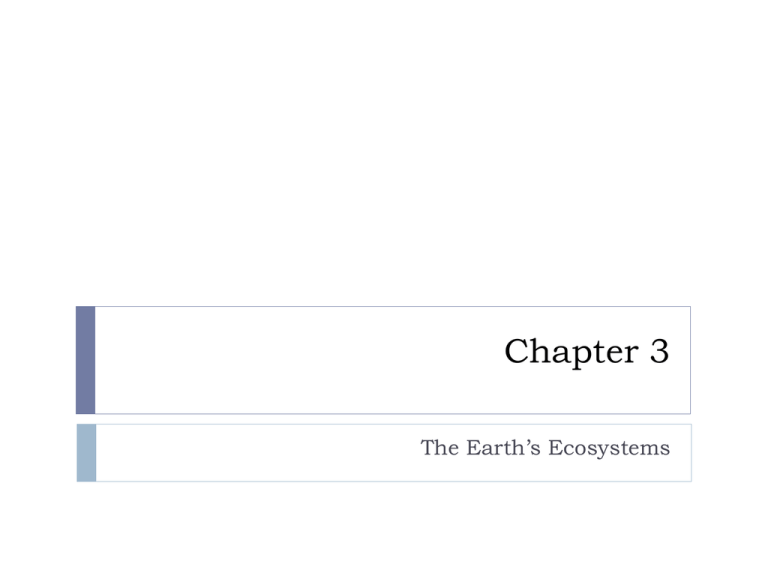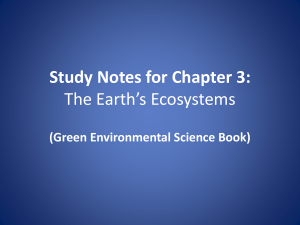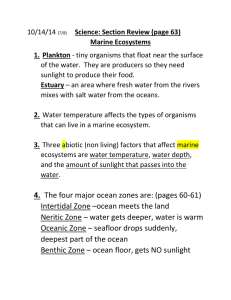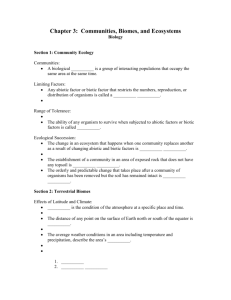Chapter 3
advertisement

Chapter 3 The Earth’s Ecosystems Bellringer How many of the 7 Land Biomes can you list without looking at your notes or book? Section 1 Land Biomes Places that have similar abiotic factors typically have similar biotic factors A Biome is a large area characterized by its climate and the plants and animals that live in the area. A biome contains related ecosystems 1. Forests Are often found in areas that have mild temperatures and plenty of rain. Type depends on temperatures and rainfall. There are 3 Types of forest Biomes: 1. Temperate Deciduous Forests The word deciduous comes from a Latin word that means “to fall off” Deciduous trees shed their leaves to save water during the winter or during the dry season A variety of animals, such as bears, snakes and woodpeckers live in these forests Coniferous Forests 2. Most trees in this forest are called conifers Conifers produce seeds in cones and have special leaves shaped like needles Leaves have a thick waxy coating with three functions: Helps leaves from drying out Protects needles from being damaged by cold weather Allows them to keep their leaves year round Trees that stay green all year and do not lose all of the leaves at one time are known as evergreen trees Common animals are squirrels, insects, finches, porcupines, elk, moose, etc. Very little light reaches the ground so few large plants can grow beneath the trees. Tropical Rain Forests 3. Have more biological diversity than other places on Earth have More than 100 different kinds of trees may grow in an area about ¼ the size of a football field. Most animals live in the canopy, or the treetops Most nutrients in the rainforest are found in the plants The soil is very thin and poor in nutrition, so many trees grow aboveground roots for extra support. Grasslands Have many names, such as steppes, prairies and pampas. Are found on every continent but Antarctica Are often flat or have rolling hills. 1) Temperate Grasslands Plants include grasses and other flowering plants Have few trees Fires, drought, and grazing prevent the growth of trees and shrubs Temperatures support small seed-eating animals and large grass eaters. 2) Savannas A savanna is a grassland that has scattered clumps of trees and seasonal rains Are found in parts of Africa, India, and South America During dry season, savanna grasses dry out and turn yellow, but their deep roots let them survive for many months without water. Is home to many large herbivores, such as elephants, giraffes, zebras, and wildebeests. Deserts Deserts are biomes that are very dry and often very hot Many plants and animals are found ONLY in deserts Plant adaptations: grow far apart Shallow widespread roots that grow just under the surface Fleshy stems and leaves to store water Leaves have a waxy coating that helps prevent water loss Animal Adaptations Active only at night Bury in the ground and are dormant during the dry season Eat flowers or leaves and store the water under their shells Tundra The tundra is a biome that has very cold temperatures and little rainfall Two types of tundra: Polar Tundra 1. Found near the North and South Poles Permafrost – layer of soil beneath the surface soil that stays frozen all the time Only the surface soil defrosts during the short, cool summers Shallow rooted plants such as grasses and small shrubs are common, and mosses and lichens grow beneath these plants When the soil defrosts it is very muddy and insects lay eggs in the mud Birds feed on these insects Other animals include musk oxen, wolves, and caribou REINDEER POLAR BEARS ALASKAN WILDFLOWERS ARCTIC TUNDRA AND ALASKAN PIPELINE 2. Alpine Tundra Also has permafrost Found at the top of tall mountains Trees cannot grow on a mountain above an elevation called the tree line Gets plenty of light and precipitation CROSS SECTION OF PERMAFROST Section 2 Marine Ecosystems Life in the Ocean Marine ecosystems are shaped by the following abiotic factors: Water temperature Water depth Amount of sunlight that passes into the water Animals and plants come in all shapes and sizes Largest animals on Earth – blue whales Plankton – tiny organisms that float near the surface of the water Many are producers – use photosynthesis Form the base of the ocean’s food chain Temperature As the water level increases, the temperature of the water decreases (the deeper the water the colder it is) This temperature change not gradual Ocean Temperature Zones Surface Zone The warm, top layer of ocean water that extends to 300 meters below sea level. Sunlight heats the top 100 meters of the surface zone Surface currents mix the heated water with the cooler water below Temps vary with the times of the year and distance from the equator Thermocline A layer of water that extends from 300 meters below sea level to about 700 meters below sea level. Water temperature drops with increased depth faster than it does in the other two zones Deep Zone Bottom layer that extends from the base of the thermocline to the bottom of the ocean. Temperatures in this zone average a chilling 2⁰ C. Temperature affects the animals that live in marine ecosystems Some have adaptations for the temperatures Some migrate from cold to warm areas of the ocean to reproduce Affects whether some animals can eat Sudden changes in temperature can cause some marine animals to die Depth and Sunlight – The Four Oceanic Zones The Intertidal Zone 1. Where the ocean meets the land Exposed to the air for part of the day Waves are always crashing on rock and sand Animals that live here have adaptations to survive exposure to air and to keep from being washed away by the waves The Neritic Zone 2. Water becomes deeper Ocean floor starts to slope downward Water is warm and receives a lot of sunlight Many interesting plants and animals, such as corals, sea turtles, fishes, and dolphins live in this zone. The Oceanic Zone 3. The sea floor drops sharply Contains the deep water of the open ocean Plankton at the water surface Animals like fishes, whales, and sharks are found here Ocean_Floors__Life_in_the _Neritic_and_Transition_Zo nes.asf The Benthic Zone 4. The ocean floor Deepest parts get no sunlight and are very cold Many organisms get food from what sinks from above Some get chemicals that escape thermal vents Ocean_Floors__Life_in_th e_Deep_Zone_Benthic Zone.asf Intertidal Areas Found near the shore Include: Mudflats – worms and crabs live there Sandy beaches – worms, clams, crabs, and plankton Rocky shores – adaptations prevent them from being washed away Rocky_Shore_Zones__Intertidal_Zone.asf Coral Reefs Found in warm, shallow areas of the neritic zone Made up of small animals called corals When corals die they leave their skeletons behind and layers of them form the reef Home for many plants and animals including algae, fish, sponges, sea stars and sea urchins Coral_Ecosystems.asf Estuaries This is an area where fresh water from streams and rivers spills into the ocean The waters are always mixing so the salt content changes Plants and animals must be able to survive these changing conditions Fresh water is very nutrient rich so estuaries support large numbers of plankton, which then provide food for many other animals estuaries.asf The Sargasso Sea Found in the middle of the Atlantic Ocean Contains floating rafts of algae called sargassums Polar Ice The Arctic Ocean and ocean around Antarctica Rich in nutrients and support large numbers of plankton Animals such as polar bears and penguins live on the polar ice Section 3 Freshwater Ecosystems Stream and River Ecosystems Water flows from melting ice and snow, or from a spring Each stream of water that joins a larger stream is called a tributary A very strong, wide stream is called a river An important abiotic factor is how fast the water flows Plants like the edges, fish live in open waters, and clams and snails live in muddy bottoms Some producers like algae and moss are attached to rocks Consumers suction to rocks or live under them Pond and Lake Ecosystems Life near Shore Area closest to the edge of lake or pond is called the littoral zone Sunlight reaches the bottom making it possible for plants and algae to grow Plants become home to small animals such as snails and insects Clams and worms bury in the mud Frogs, salamanders, turtles, fish and snakes also live in this zone Life Away from Shore The Open-water zone extends from the littoral zone across the top of the water Large mouth bass Goes as deep as sunlight can reach Home to bass, lake trout, and other fishes Many photosynthetic plankton also live there Lake trout Beneath the open-water zone is the deep-water zone, where no sunlight reaches Catfish, carp, worms, crustaceans, fungi, and bacteria live here CARP CATFISH Often feed on dead organisms that sink from above CRUSTACEANS Wetland Ecosystems An area of land that is sometimes underwater or whose soil contains a great deal of moisture is called a wetland Play important roles in flood control Help to replenish underground water supplies Marshes Treeless wetland ecosystem where plants, such as grasses grow Often found in shallow areas along the shores of lakes, ponds, rivers, and streams Swamps A wetland ecosystem in which trees and vines grow Found in low-lying areas and beside slow-moving rivers Essential_and_Endangered __Wetland_Biomes.asf (25:00) From a Lake to a Forest Over time, ponds and lakes fill with sediment Plants grow in the new soil Shallow areas fill in first and plants slowly grow closer and closer to the center of the pond or lake What is left becomes a wetland, and eventually a forest







